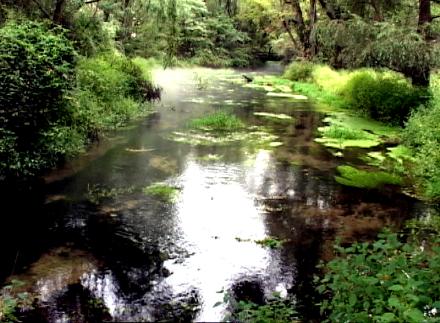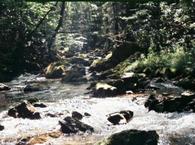
The Letort Spring Run originates from some very large limestone springs, and flows North through meadows of grass and brush then continues right through in the town of Carlisle Pennsylvania. The Letort is so clear that its depth is deceiving. You may think that it is only a few inches deep, but when you step in, you will be surprised. Also the Letort is narrow not averaging more than 20 feet wide.
Just south of Bonny Brook Road, begins the Heritage Trout Angling regulations area. The area extends 1.5 miles; from 300 yards above the bridge on Twp. Route 481 downstream to the Reading Railroad Bridge at the southern edge of Letort Spring Park. This stretch is catch-and-release fly fishing, with barbless-hooks only. The catch and release water tends to have more larger brown trout than the other water but it requires great skill on the part of the angler.
After passing Bonny Brook Quarry, the Letort flows through a section of gravel-strewn riffles, then through Marinaro's Meadow. Just below the end of the Hertiage Trout Angling section, the Letort flows through Letort SpringParkw here you'll still find good numbers of wild trout. Upon leaving the park, the Letort flows through the town of Carlisle Pennsylvania. Below Carlisle and just below the barracks at Post Road, the Letort returns to a great trout stream. Here the creek runs through some meadows and small developments before flowing into Conodoquinet Creek.
The lower end of the stream has some runs and riffles areas and the faster water makes it a little easier to catch trout. It has some open areas that are easier to cast to and easier to fish than the middle or upper areas of the stream which have more bushes and trees.
The Letort has large beds of cress that in some cases almost cover the width of the stream making it difficult to know how deep it is at any one point. The cress swirls the currents in a manner that creates conflicting currents just about everywhere. These conflicting currents and multiple feeding lanes make it very difficult to get a "dead free" drift.
Fishing the Letort:
The Letort's brown trout have most likely seen about every fly and every angler that comes near its waters so as you might guess, they are not easy to catch. A stealthy approach in required to fool these wild browns and the closer your fly looks and acts like the real thing, the better your chances of fooling a trout. A fly from the “Perfect Fly” line of flies at TroutUniversitywill definitely improve your chances.
The water conditions make it necessary to fish very light leaders and
tippets. The big wild brown trout will have all the cover they need to wrap around and break the very light line or your tippet, so be careful. Also, a bad cast will make it necessary to move somewhere else. Get a bad cast or a bad drift and you will need to cast to another location. Let the trout see you and you are finished in that area of the little stream.
When you wade you have to be extra careful because the water is clear, basically shallow and the trout are difficult to approach. When you do get into the right position, you must make a very accurate presentation. If you make the wrong cast, you may have to wait several minutes before the fish will begin to rise again. So, make your first cast counts.
You want to take advantage of the hatch because it is probably the easiest time you are going to have to catch trout. Hatches on the Letort are not as prolific as on some of the other spring streams. There still are good BWO and Sulphurhatches along with many Terrestrials, Midges, and Tricos during the summer. Cress Bugs also are important flies on the Letort, and should be included in your box if you plan to go there. When the water is off-color from rain, try using the mudler minow and a variety of other streamers. The next time you plan a trip to South Central Pennsylvania, be sure to stop by Letort Spring Run and fish for its famous wild brown trout.
Tip: Cloudy days are always the best days to fish the Letort. Bright, clear days add another problem to the already tough fishing situation. The trout will hide in heavy cover out of the sun and that makes it just that much more difficult to catch them. You are far better off fishing low light conditions. Early morning, late evenings and cloudy, rainy days are best.
Spring:
Spring is the best time to fish the Letort because there are more hatches and the fish seem a little more aggressive during the spring. In spring the large browns will take BWOs and Sulphurs, as well as a variety of Terrestrials and Midges.
Summer:
Summer can be okay. There are some sulphur mayflies in the stream and there is a trico hatch that occurs in late summer in parts of the stream.
Fall and Winter:
There can be hatches of BWOs in the fall that remain good in the fall months. In winter the warm afternoons will provide some action on the Letort.
Access is easy from Rt. 481, Rt 11 and other points in the Carlisle area of pennsylvania including the city itself.
View Northeast USA in a larger map





